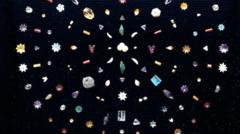In a move that has captivated the art world while stirring ethical concerns, Sotheby's prepares to auction a remarkable collection of nearly 1,800 jewels associated with the remains of the Buddha. This cache, comprising pearls, rubies, sapphires, and gold, was unearthed in 1898 from a stupa in northern India, an archaeological site of profound significance. Nicknamed one of the most extraordinary archaeological finds of the modern era, these treasures have languished in private possession until now.
The relics originated from a breathtaking discovery made by William Claxton Peppé, an English estate manager who excavated the stupa in Piprahwa, near the Buddha's birth site in modern-day Uttar Pradesh. Accompanying this glittering trove were bone fragments believed to belong to the Buddha, further solidifying the jewels' sacred history. As the auction approaches, experts and community leaders alike grapple with pressing ethical questions about the sale of items deeply embedded in India's cultural and spiritual legacy.
Nicolas Chow, chairman of Sotheby's Asia, hailed the auction as an unprecedented occasion, while at the same time, voices of dissent have emerged. Art historian Naman Ahuja raises pivotal questions about the legitimacy of selling such sacred artifacts: "Are the relics of the Buddha a commodity that can be treated like a work of art to be sold on the market? And who has the ethical authority to auction them?"
Opposition to the auction extends beyond academia. Buddhist leaders express concern that the gems are entwined with human remains, which many believe should never be commodified. Amal Abeyawardene of the British MahaBodhi Society emphasized the sacred nature of the gems and relics, originally entrusted to the Sakyamuni clan, and argues for their preservation rather than commercialization.
Chris Peppé, the great-grandson of the excavator, defended the decision to auction, stating that previous attempts to donate the relics were met with various hurdles, making the auction appear the fairest alternative to transfer them to Buddhist communities. Peppé acknowledges his family's complex history with the relics while maintaining the authenticity and provenance of the treasures.
Throughout this debate, the notion of custodianship has emerged as a focal point of contention. Critics argue that the term does not grant owners the right to sell these artifacts, while supporters assert that a due diligence process has been established for the auction. Ashley Thompson and Conan Cheong, prominent experts in Southeast Asian art, have highlighted the potential implications of auctioning items linked to human remains, questioning the framework that allows for such transactions.
As collectors prepare for the impending auction, the broader ramifications of commodifying symbolic relics from Buddhism pose vital questions about ownership and the ethics of cultural artifacts. In a time where colonial histories are critically reassessed, the fate of these relics raises profound inquiries into who rightfully claims the past, and how societies choose to honor their collective heritage. The auction, set for Wednesday, signals not just a financial transaction but a reckoning with cultural identity, historical relationships, and ethical stewardship.


















